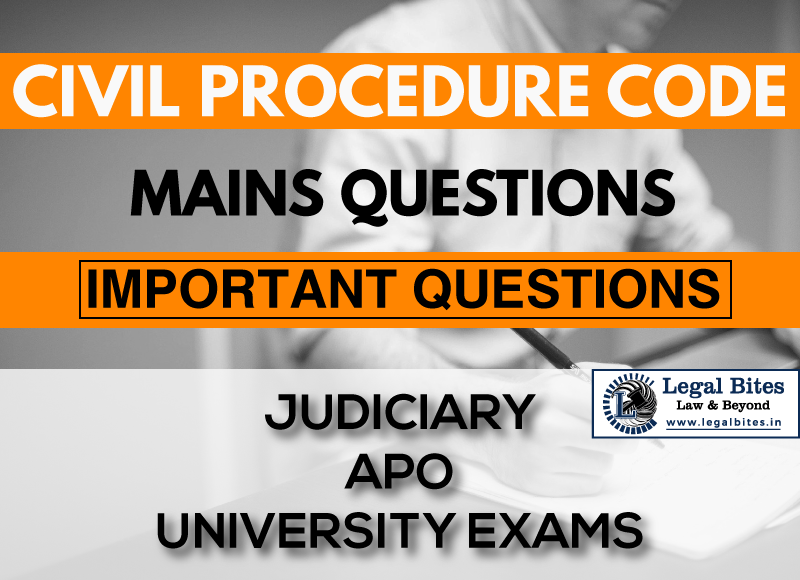What is the meaning of the term 'Pleading’? What are the fundamental rules of pleadings? Refer to relevant provisions.
Find the answer to the mains question only on Legal Bites.

Question: What is the meaning of the term 'Pleading’? What are the fundamental rules of pleadings? Refer to relevant provisions. [WB J 1995, MPCJ 2006, UPCJ 2013, Raj J 1988]Find the answer to the mains question only on Legal Bites. [What is the meaning of the term 'Pleading’? What are the fundamental rules of pleadings? Refer to relevant provisions.]AnswerOrder VI of the Code deals with Pleadings. According to Rule 1, Pleading means plaint or written statement. According to P. C....
Question: What is the meaning of the term 'Pleading’? What are the fundamental rules of pleadings? Refer to relevant provisions. [WB J 1995, MPCJ 2006, UPCJ 2013, Raj J 1988]
Find the answer to the mains question only on Legal Bites. [What is the meaning of the term 'Pleading’? What are the fundamental rules of pleadings? Refer to relevant provisions.]
Answer
Order VI of the Code deals with Pleadings. According to Rule 1, Pleading means plaint or written statement. According to P. C. Mogha, pleadings are statements in writing drawn up and filed by each party to a case stating what his contention will be at trial and giving all such details as his opponents need to know for his defence.
Object of Pleading: The object of pleading was explained by the Supreme Court in Ganesh Trading Co. v. Moji Ram, AIR 1978 SC 484. Pleading has the following objects:
a) To give each side, intimation of the case of the other so that they are not taken by surprise.
b) To enable the court to determine the issues between the parties.
c) To diminish expenses and delay in the conduct of suits.
Fundamental Rule of Pleading
Order VI Rule 2 lays down the fundamental principle of pleading. This rule provides for the general caution a litigant has to exercise while drafting his pleading and is thus known as the golden rule of pleading. It provides that:
1) Every pleading must contain only material facts on which the party pleading relies i.e. unnecessary facts having no bearing upon the cause of action must not be stated (also known as Facta Probanda). It is for the court to apply the law to the facts pleaded. Thus, the existence of any custom or usage is a question of fact and it must be pleaded but a plea about the maintainability of the suit raises a question of law and need not be pleaded.
However, a mixed question of fact and law should be specifically pleaded. Rule 13 further provides that a presumption raised in one’s favour is not required to be pleaded as these are matters of evidence.
2) The pleading must not contain any evidence of the facts, by which they would be proved, which is required only after settlement of issues (also known as Facta Probantia). The expression ‘material facts’ is not defined in the court. In the case of Udhav Singh v. Madhav Rao Scindia, AIR 1976 SC 744, the Supreme Court defined the expression as ‘all the primary facts which must be proved at the trial by a party to establish the existence of the cause of action or his defence’.
In Virendra Nath v. Satpal Singh, AIR 2007 SC 581, the Supreme Court held that material facts are those facts upon which a party relies for his claim or defence. Plaintiff’s cause of action and the defendant’s defence depends on material facts. These facts are to be distinguished from a particular which only provides the details of the case. Their purpose is to amplify, refine and embellish material facts. Rule 4 provides the cases in which particulars are to be given. It provides that all necessary particulars like misrepresentation, fraud, breach of trust, wilful default or undue influence must be stated in the pleadings. The pleading should contain facta probanda and not facta probantia.
3) The pleading of the parties must not state any law through which such facts must be appraised by the court, but a mixed question of law and fact may be stated in the pleadings.
4) That all such material facts must be stated in concise form i.e. in brief and to the point, further it is provided that, every pleading shall be divided into paragraphs, numbers consecutively and every allegation should be contained in separate paragraphs. Dates, sums and numbers should be expressed in figures as well as in words.
Important Mains Questions Series for Judiciary, APO & University Exams
- CPC Mains Questions Series: Important Questions Part – I of X
- CPC Mains Questions Series: Important Questions Part – II of X
- CPC Mains Questions Series: Important Questions Part – III of X
- CPC Mains Questions Series: Important Questions Part – IV of X
- CPC Mains Questions Series: Important Questions Part – V of X
- CPC Mains Questions Series: Important Questions Part – VI of X
- CPC Mains Questions Series: Important Questions Part – VII of X
- CPC Mains Questions Series: Important Questions Part – VIII of X
- CPC Mains Questions Series: Important Questions Part – IX of X
- CPC Mains Questions Series: Important Questions Part – X of X

Mayank Shekhar
Mayank is an alumnus of the prestigious Faculty of Law, Delhi University. Under his leadership, Legal Bites has been researching and developing resources through blogging, educational resources, competitions, and seminars.
